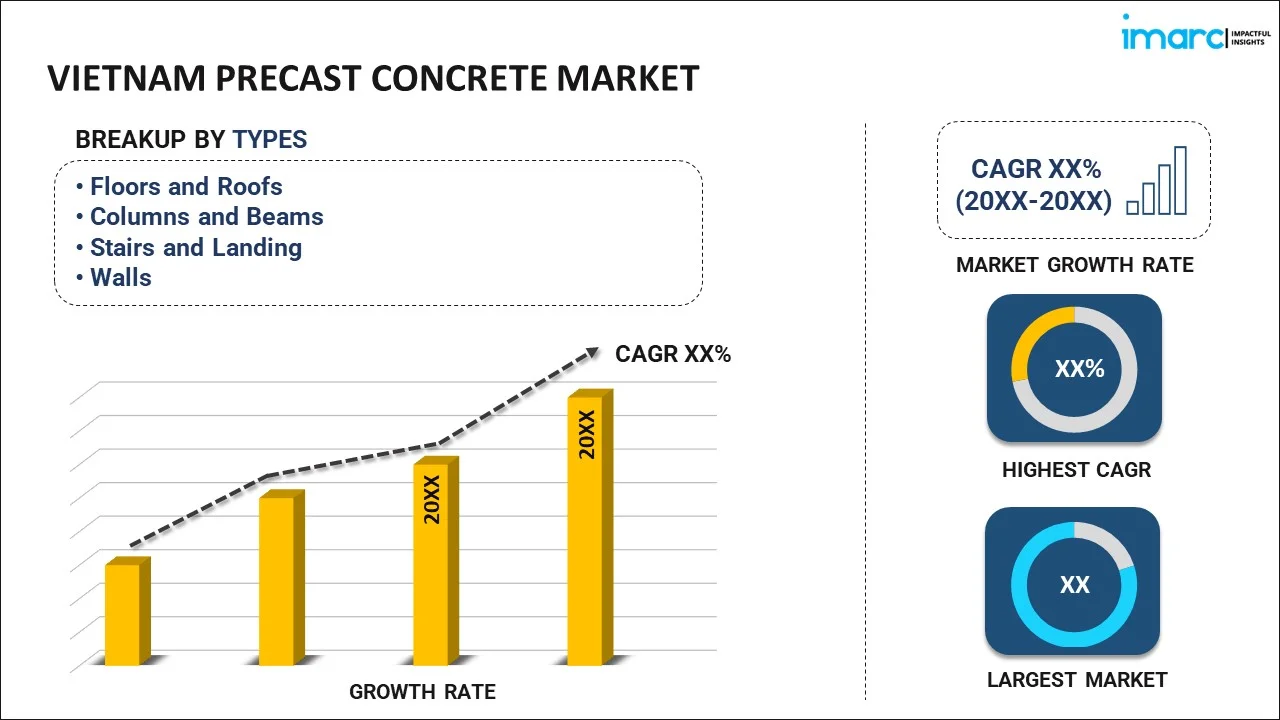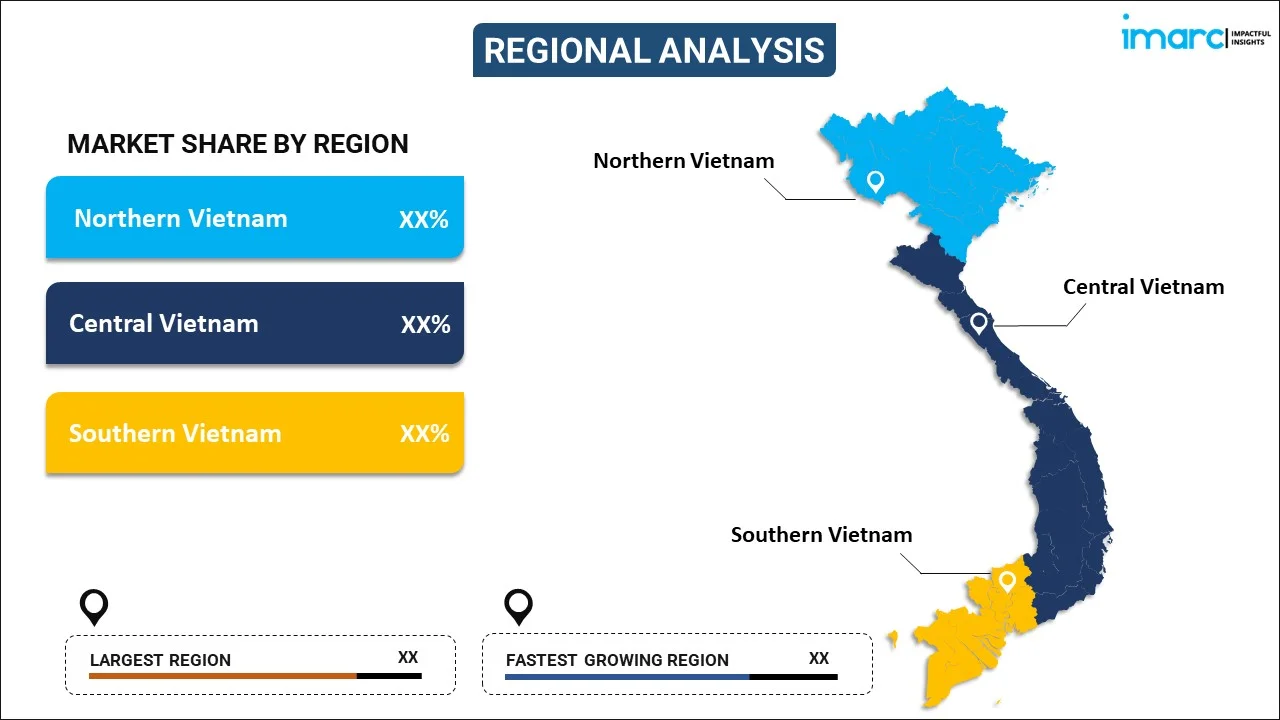
Vietnam Precast Concrete Market Report by Type (Floors and Roofs, Columns and Beams, Stairs and Landing, Walls), Product (Structural Building Components, Architectural Building Components, Transportation Products, Water and Waste Handling Products, and Others), End Use (Residential, Non-Residential), and Region 2025-2033
Market Overview:
Vietnam precast concrete market size is projected to exhibit a growth rate (CAGR) of 7.4% during 2025-2033. The growing utilization of computer-aided design (CAD) and building information modeling (BIM) software in the construction industry, rising environmental awareness among the masses, and rapid urbanization represent some of the key factors driving the market.
|
Report Attribute
|
Key Statistics
|
|---|---|
|
Base Year
|
2024 |
|
Forecast Years
|
2025-2033 |
|
Historical Years
|
2019-2024
|
| Market Growth Rate (2025-2033) | 7.4% |
Precast concrete is manufactured off-site in controlled environments and then transported to the construction site for assembly. It is produced in controlled conditions, reducing the likelihood of defects and ensuring consistent quality. It can be customized to achieve a wide range of shapes, finishes, and textures, allowing for the creation of visually appealing and unique structures. It reduces construction time and labor costs, making it a cost-effective choice. It can incorporate recycled materials and reduce waste on construction sites. It can contribute to green building certifications due to its efficient use of materials and reduced waste. It is widely used in the construction of residential buildings, including apartments and houses. It is also utilized in office buildings, retail spaces, and shopping centers. Moreover, it is employed in the construction of schools, hospitals, and government buildings. Additionally, as it offers a higher degree of quality control compared to traditional on-site casting, the demand for precast concrete is increasing in Vietnam.
Vietnam Precast Concrete Market Trends:
Rapid urbanization and the rising need for infrastructure development in Vietnam represent one of the key factors catalyzing the demand for precast concrete, as it can accelerate construction timelines, making it an attractive choice for meeting this demand, particularly in densely populated urban areas. Along with this, the growing environmental awareness among the masses is offering a favorable market outlook in the country. Precast concrete can contribute to sustainability goals by incorporating recycled materials, reducing waste on construction sites, and improving energy efficiency. Furthermore, advancements in precast concrete technology are making it more efficient and adaptable. The rising utilization of computer-aided design (CAD) and building information modeling (BIM) software in the construction industry is streamlining the design and manufacturing processes. Additionally, automation and robotics are increasingly employed in precast concrete production, further enhancing efficiency and quality. Moreover, governing authorities in Vietnam are actively promoting infrastructure development and affordable housing initiatives. They are continuously investing in large-scale infrastructure projects, such as bridges, highways, and metro systems, which is driving the demand for precast concrete. Besides this, increasing collaborations among stakeholders in the construction industry, including developers, contractors, and precast concrete manufacturers, are influencing the market positively in Vietnam. Strategic partnerships and joint ventures are helping to pool resources and expertise, resulting in the successful execution of complex projects. Besides this, the growing need for affordable housing in Vietnam to accommodate its expanding urban population is catalyzing the demand for precast concrete due to its cost-effective and time-efficient nature. In addition, several manufacturers are exploring international markets, exporting their products to neighboring countries in Southeast Asia, which is bolstering the market growth.
Vietnam Precast Concrete Market Segmentation:
IMARC Group provides an analysis of the key trends in each segment of the market, along with forecasts at the country level for 2025-2033. Our report has categorized the market based on type, product, and end use.
Type Insights:

- Floors and Roofs
- Columns and Beams
- Stairs and Landing
- Walls
The report has provided a detailed breakup and analysis of the market based on the type. This includes floors and roofs, columns and beams, stairs and landing, and walls.
Product Insights:
- Structural Building Components
- Architectural Building Components
- Transportation Products
- Water and Waste Handling Products
- Others
A detailed breakup and analysis of the market based on the product have also been provided in the report. This includes structural building components, architectural building components, transportation products, water and waste handling products, and others.
End Use Insights:
- Residential
- Non-Residential
The report has provided a detailed breakup and analysis of the market based on the end use. This includes residential and non-residential.
Regional Insights:

- Northern Vietnam
- Central Vietnam
- Southern Vietnam
The report has also provided a comprehensive analysis of all the major regional markets, which include Northern Vietnam, Central Vietnam, and Southern Vietnam.
Competitive Landscape:
The market research report has also provided a comprehensive analysis of the competitive landscape. Competitive analysis such as market structure, key player positioning, top winning strategies, competitive dashboard, and company evaluation quadrant has been covered in the report. Also, detailed profiles of all major companies have been provided.
Vietnam Precast Concrete Market Report Coverage:
| Report Features | Details |
|---|---|
| Base Year of the Analysis | 2024 |
| Historical Period | 2019-2024 |
| Forecast Period | 2025-2033 |
| Units | Billion USD |
| Scope of the Report | Exploration of Historical Trends and Market Outlook, Industry Catalysts and Challenges, Segment-Wise Historical and Future Market Assessment:
|
| Types Covered | Floors and Roofs, Columns and Beams, Stairs and Landing, Walls |
| Products Covered | Structural Building Components, Architectural Building Components, Transportation Products, Water and Waste Handling Products, Others |
| End Uses Covered | Residential, Non-Residential |
| Regions Covered | Northern Vietnam, Central Vietnam, Southern Vietnam |
| Customization Scope | 10% Free Customization |
| Post-Sale Analyst Support | 10-12 Weeks |
| Delivery Format | PDF and Excel through Email (We can also provide the editable version of the report in PPT/Word format on special request) |
Key Questions Answered in This Report:
- How has the Vietnam precast concrete market performed so far and how will it perform in the coming years?
- What has been the impact of COVID-19 on the Vietnam precast concrete market?
- What is the breakup of the Vietnam precast concrete market on the basis of type?
- What is the breakup of the Vietnam precast concrete market on the basis of product?
- What is the breakup of the Vietnam precast concrete market on the basis of end use?
- What are the various stages in the value chain of the Vietnam precast concrete market?
- What are the key driving factors and challenges in the Vietnam precast concrete?
- What is the structure of the Vietnam precast concrete market and who are the key players?
- What is the degree of competition in the Vietnam precast concrete market?
Key Benefits for Stakeholders:
- IMARC’s industry report offers a comprehensive quantitative analysis of various market segments, historical and current market trends, market forecasts, and dynamics of the Vietnam precast concrete market from 2019-2033.
- The research report provides the latest information on the market drivers, challenges, and opportunities in the Vietnam precast concrete market.
- Porter's five forces analysis assist stakeholders in assessing the impact of new entrants, competitive rivalry, supplier power, buyer power, and the threat of substitution. It helps stakeholders to analyze the level of competition within the Vietnam precast concrete industry and its attractiveness.
- Competitive landscape allows stakeholders to understand their competitive environment and provides an insight into the current positions of key players in the market.
Need more help?
- Speak to our experienced analysts for insights on the current market scenarios.
- Include additional segments and countries to customize the report as per your requirement.
- Gain an unparalleled competitive advantage in your domain by understanding how to utilize the report and positively impacting your operations and revenue.
- For further assistance, please connect with our analysts.
 Inquire Before Buying
Inquire Before Buying
 Speak to an Analyst
Speak to an Analyst
 Request Brochure
Request Brochure
 Request Customization
Request Customization




.webp)




.webp)












